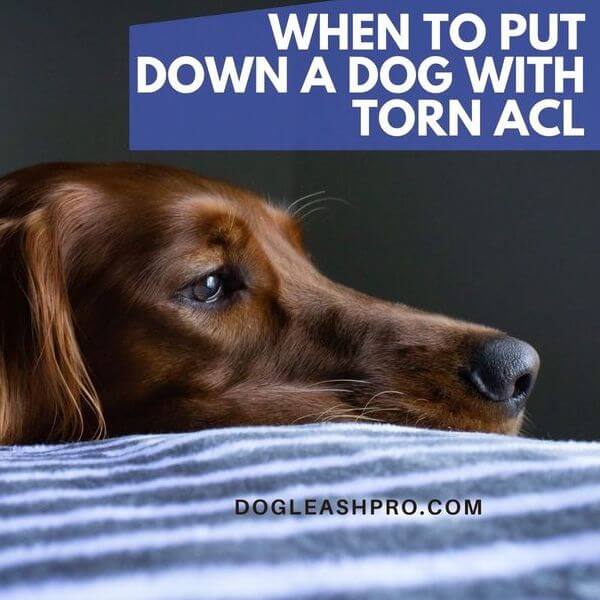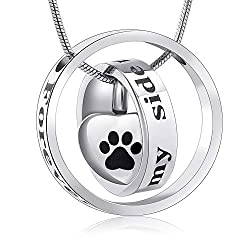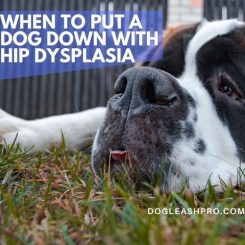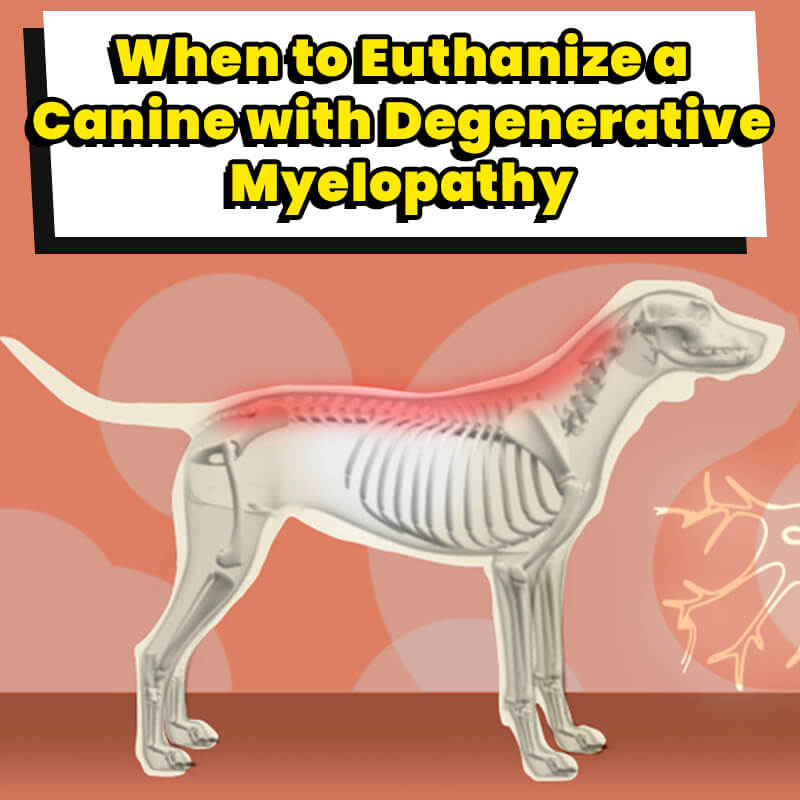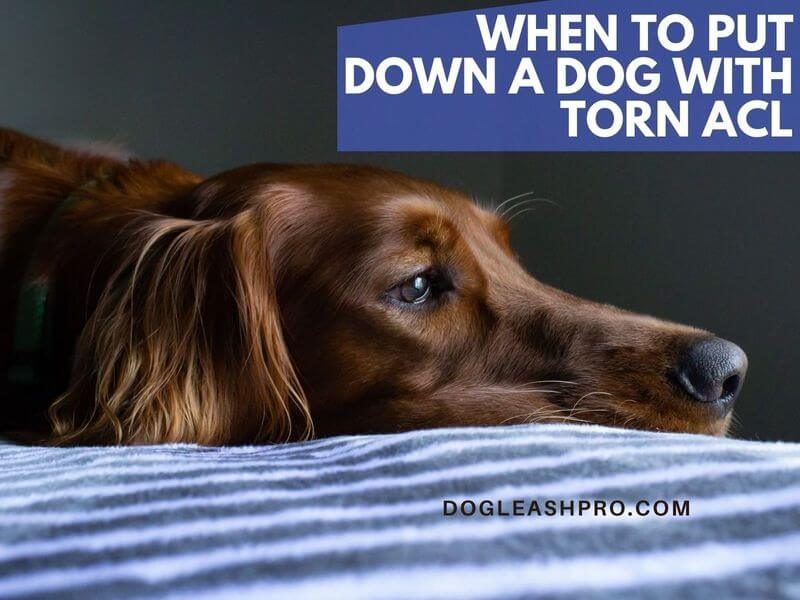
Dogs are naturally active and they love to run around and jump as high as they could. But when they injure their hind legs, life can feel miserable as it prevents them from moving around. Having torn ACLs is one such injury.
Some of the dog breeds prone to having torn ACL injuries are also affected by other diseases like hemangiosarcoma so make sure to read our blog on when to euthanize a dog with hemangiosarcoma to eliminate other possible causes and stay informed.
When to put a dog down with torn ACL? Unfortunately, ACL surgery is costly. If you don’t have the proper insurance or enough cash to pay for ACL surgery, the only option left may be to consider putting down your dog with a torn ACL. Although treatments are available, as your pup ages, their pain and suffering may overweigh their quality of life. At that point, euthanasia is the most humane decision.
Thus, it’s best to get an insurance policy sooner. Below, we will discuss what torn ACLs means for your pup’s quality of life and what treatment options are available so you’re not left with just one option of euthanasia.
Table of Contents
What is a torn ACL among dogs?
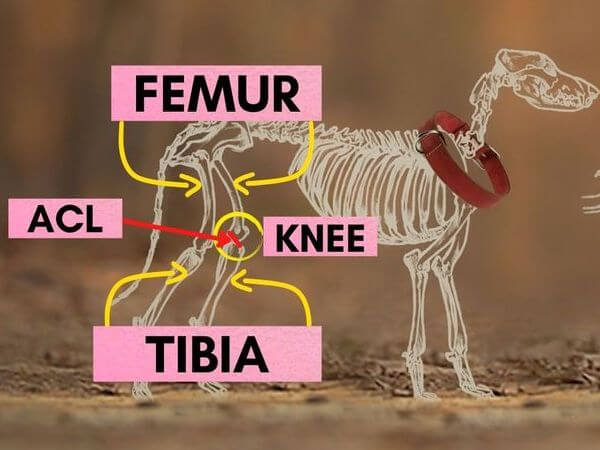
When a dog has a torn ACL or Anterior Cruciate Ligament, it means their hind legs are affected. In canine terms, it’s technically called CCL or cranial cruciate ligament. Since ACL is easier to remember than CCL, many use the term ACL.
A dog’s hind legs include their knees and ACLs which are located between the femurs and the tibias. The femur is the top bone in a dog’s hind leg. The tibia is the bottom bone. The ACL is a ligament at the anterior part of your dog’s knee to help him move around. An ACL injury is when this ligament is torn.
Whenever your dog stands, runs or walks, their ACLs are constantly under some sort of pressure from both the femurs and the tibias. Many pups risk getting a knee injury when they’re running and they make a quick sudden change in direction. This causes their knees to twist suddenly and as a result, they get a tear or sprain to their ACLs.
Other causes of an ACL tear can be due to excessive weight, hyperextension, or simply bad breeding.
Dogs with torn ACLs will experience excruciating pain and will be unable to stand, walk or run around. If you notice this, visit your vet right away. Your pooch needs to be treated immediately. If left untreated, torn ACL injuries can affect the spine and cause spine curvature.
While surgery is necessary, other treatment options are also available.
In the event that surgery or other treatment options prove unsuccessful, making the decision to put the dog down may be the most humane option.
Helping you decide when to put a dog down with torn ACL
Before you consider euthanasia, consider your options. There are several treatment options available and ways you can help your dog live more comfortably. Discuss with your vet before making any hasty decisions. You’re not alone and qualified professionals are there to help.

Total Time Needed :
3
Months
30
Minutes
Total Cost:
650
USD – 6000+ USD
Required Tools:
Things Needed?
Steps to decide if you should euthanize your dog with torn ACL:
Dog torn ACL symptoms
When your canine tore its ACL, the symptoms depend on whether they have a major or a minor sprain. Minor sprains will cause some level of discomfort and you’ll notice your pup limping. The good news is that it should heal itself within a couple of weeks. Try to limit their activities like running around.
Major sprains are more serious. This means your pooch has torn ACLs which causes lameness in their hind legs so they won’t be able to walk properly. Instead, you’ll see them hopping or skipping to avoid putting weight on their hind legs when they’re walking.
According to Colorado State University, you’ll notice your dog not being able to sit “square” anymore and having to put their leg out to their side when they sit down. They may also have difficulty jumping into the car. There may be a decrease in activity level and unwillingness to play.
Other signs include a change of walking gait, redness, swelling, instability, and immobility. If your dog doesn’t get ACL surgery after a major sprain, his body will learn to compensate for the torn ACL. Consequently, scar tissues will develop and cause their knee joint to become stiff. Eventually, he will not be able to move as much and this leads to muscle loss.
Dog breeds prone to torn ACL injuries
The size of your pup and the dog breed can affect when the best time to euthanize a dog with a torn ACL is. For instance, larger dog breeds are more prone to torn ACL injuries.
Unlike smaller dog breeds, when large dogs receive a tear in the ACL, it’s harder for them to distribute their weight onto their unaffected leg so they put more weight over the ACL injury. As a result, larger dogs will experience more pain. Without treatment and surgical intervention, it can get worse.
A dog’s genetic makeup can make them prone to torn ACL injuries. Heavy body weight from larger dogs can put constant pressure on their knee joints which makes them prone to torn ACL injuries.
It may also be impossible for large dogs to live a normal good life after a severe case of torn ACL.
Here is a list of dog breeds that are more predisposed to getting a torn ACL.
- American Staffordshire Terriers
- Bichon Frises
- German Shepherds
- Golden Retrievers
- Labrador Retrievers
- Newfoundlands
- Rottweilers
- Saint Bernards
Treatments available for dogs with ACL injury
When dogs suffer from a massive ACL tear, they need to be treated right away. If left untreated, the condition may worsen as the ACL tear will not heal on its own. To heal properly, the tears on the cruciate ligament needs to be sewn back together.
Hence, ACL surgery is generally the first option. It’s the most effective way to fully heal a torn ACL. The invasive surgery will reconstruct your dog’s ACL so that once it is healed, your dog won’t feel pain and can live a happy life. Expect a long recovery period after the surgery.
Another treatment option is prolotherapy or proliferation therapy, which is usually for large dogs with torn ACLs. This is when an irritant is injected into the affected cruciate ligament to assist in the healing process and help reduce the pain. Over time, the torn ACL will heal and your pup’s quality of life will improve.
Alternatively, if surgery isn’t an option, your pooch can wear a leg brace to restrict his movement while supporting his legs. The price range for knee braces is from $400 to $700. This will allow him to at least still move around while he is recovering. Expect to limit their activity for at least six months so their hind legs can heal on their own.
Your vet can also give your dog non-steroidal anti-inflammatory drugs (NSAID) to treat the symptoms and relieve the pain. Many dog owners choose to go with dog pain-relieving injections if they can’t afford the ACL surgery. Note that the cost of monthly injections and the pain your dog goes through force many owners to put their dog down.
Note that while these medications and injections help with pain management, they won’t prevent the onset of arthritis in dogs.
Low weight-bearing exercise such as swimming is extremely helpful as it doesn’t put stress on your dog’s joints, ligaments, and muscles. Ideally, your dog should swim 2 to 3 times a week in order to build his muscle and get mental and physical stimulation.
How Long does a Torn ACL in a dog take to heal?
Tibial plateau leveling osteotomy or TPLO is a type of surgery done on dogs with a torn ACL. The dog can be taken home after the surgical procedure but it will take an average of 12 to 16 weeks for the dog to heal completely.
Cost of ACL surgery
The cost of ACL surgery for dogs can be quite expensive. In the United States, dog ACL surgery cost can range between $650 and over $6,000, or between $2,000 and $3,000 for each knee. It can even go as high as $10,000, depending on your pup’s overall health.
If you prefer to go to an upscale vet clinic, the cost of an ACL surgery can be higher. Speak with your vet to see how much ACL surgery cost with insurance.
Many pet owners are unable to afford this overly expensive price which is why their next best decision is to put down their dog with a torn ACL. It’s a difficult decision to make but seeing your pooch suffer while living a poor quality of life is simply pure hell.
Dog ACL surgery success rate
The success rate of ACL surgery among healthy dogs is generally around 85% to 90%. Sadly, it’s possible that vets may not recommend surgery for older dogs with additional health problems.
Can a dog live with a torn ACL?
Yes and no. The answer depends on two important factors – your canine’s current condition and the extent of the ACL tear. If it’s a minor tear, external care can help most dogs recover from an ACL injury and surgical procedures may not be necessary.
Most of the time, you may not know your pup has a torn ACL. Many leg problems develop gradually from unhealthy ACLs. For instance, under constant pressure from running or walking, the filament-like bands or ACL can start to tear over time. While these mild sprains can heal over time, some turn into partial or full tears when your pup makes any sudden movement.
When dogs have a severe case of torn ACL, then surgery is required. After the surgery, it will usually take at minimum three weeks for your dog to start standing up and walking again.
In most cases, undergoing surgery will allow dogs with torn ACL to recover fully so they can live a normal life again. However, it’s best to go with activities that do not put a lot of pressure on the cruciate ligament.
Dr. Phil Zeltzman on the PetHealthNetwork said it is possible for your dog to survive with a torn ACL if you can’t afford surgery but that if your dog undergoes surgery, their quality of life will improve.
If you have older dogs that have other underlying illnesses such as arthritis, then the decision of whether to put down a dog with a torn ACL becomes necessary since arthritis is incurable by surgery at this time.
You are not alone in making this difficult decision. Your dog’s vet will see if there are other treatment options available that can improve your pooch’s quality of life before considering euthanasia.
Can a dog recover from an ACL tear without surgery?
It is possible for dogs to recover from an ACL tear without surgery. One way is to wear a leg brace. It supports the dog’s hind legs while comfortably restricting their movement. While recovering from the torn ACL, they can still move around.
The leg brace is also more affordable than ACL surgery.
Generally, it’s more difficult for larger dogs to live comfortably if they go without torn ACL surgery.
What happens if you don’t treat a torn ACL?
There are various consequences If you don’t address the issue of a torn ACL in your dog. Here are some 3 of those:
1. Decreased range of motion
Since dogs with torn ACL experience pain, it follows that their range of motion gets limited. They can no longer play and run as they used to, going up and down the stairs become a difficult task, and they can no longer join family outings, competitions, or work as therapy or service dogs.
2. Muscle atrophy
Decreased or lack of movements lead to muscle atrophy or the thinning of muscles.
3. Degenerative joint disease
An untreated ACL can lead to other health problems such as arthritis. This is because a torn ACL destabilizes the knee which then results to the rubbing of the thigh and the shin bones.
Aside from arthritis, an untreated ACL can possibly cause the growth of bone spurs which is another painful condition.
How to care for a dog with a torn ACL
There are several ways to care for a dog with a torn ACL. Below we list a few ways you can help make your dog feel more comfortable at home.
1. Provide your dog with a comfortable bed. Place water and food next to his bed. It’s best to go with an elevated bed so it doesn’t put pressure on their joints and hind legs.
2. If your pooch still want to climb onto your sofa or your bed when you’re not there, place a dog ramp next to the furniture that your pup loves to hang out in.
Is It Good to Walk a Dog with Torn ACL?
This is not a good idea because it will only strain the injured leg. If you feel like taking your dog for a walk with Torn ACL, make sure your dog is wearing an ACL dog brace so it provides support to their knee joints.
Deciding if you should euthanize dog with torn ACL
Deciding to euthanize a dog with torn ACL can be difficult. Before you consider whether to put down your dog with a torn ACL, observe both their behaviors and their quality of life.
Keep in mind that dogs don’t always show pain in the same ways that humans do. Their pain becomes apparent through their physical symptoms which affect their behavior and mood.
Here are some key questions to ask yourself before considering euthanasia.
- Is your dog able to drink and eat normally without your assistance?
- After lying down, can your pup stand up by himself without your help?
- Can your four-legged friend stand, walk, and run without experiencing pain?
- Is your pup sleeping through the night? Or is he waking up every so often due to pain?
- ACL surgery is costly. Can you afford to pay for the ACL surgery? If so, are you cover by insurance or will you be paying out of pocket?
After you’ve considered these questions, inform your veterinarian of your observation. They are the best people to help you answer these questions.
You’ll also want to ask the vet the following question:
- What is the success rate after your pooch undergoes torn ACL surgery?
If your vet tells you that there is a low success rate following surgery, then a dog with torn ACL may be a candidate for euthanasia. Additionally, a dog that can’t eat, drink, sleep stand up, or walk normally will live a poor quality of life.
Sometimes, the ACL surgery did not work out as expected and the last option would be euthanasia.
It’s heartbreaking to see our pooch live a life of pain and suffering. Your vet will help you decide whether you should consider putting down your dog with a torn ACL. It’s important to consult with your vet before choosing to go ahead and euthanize your dog.
How does dog euthanasia work?
Some owners prefer to have this procedure done at home in the comfort of surrounding family members. Others will go into the vet’s clinic to have this done. Either way, your vet will handle the entire procedure and answer any questions you may have.
Here’s how dog euthanasia works:
Your dog will lie down on a table for this procedure. The vet will administer an injection of sodium pentobarbital with a syringe. It is an anesthetic drug that will quickly cause your dog to lose consciousness and painlessly stop the heart.
You’ll have a few moments with your dog. Think back to any fond memories you had with your furry companion and thank them for all the happy memories they shared with you and your family. Your vet will then confirm the time of passing by checking for a heartbeat.
This is the last time you’ll see your canine companion but know that they are now free from pain. You made the humane decision so that your dog no longer has to suffer. They are able to leave this earth in a painless way.
Remembering your dog
After the euthanization procedure, dog owners can choose to have either a traditional burial (at a pet cemetery or in your yard if your town allows it) or a cremation.
Many owners choose to cremate their beloved canine companion in order to keep the remains in the house within an urn. The urn could be a necklace or a memory box. Some also choose to customize the urn with their favorite memories or quotes.
Pet Insurance
The main treatment for dogs with torn ACLs is ACL surgery. It is quite expensive especially if you’re not prepared. This is why we recommend getting pet insurance. When your dog is cover under an insurance policy, the plan can cover part of the high medical expenses.
It’s best to get pet insurance before you need it. You never know when your dog may get a torn ACL. In the event of an emergency, it will help you pay for your dog’s treatment.
Do not wait until your pup needs insurance to get it. Covering your dog now keeps the monthly payment reasonably low and gives you peace of mind.
Conclusion
Making the decision to put down your dog with a torn ACL is difficult but it helps to end the suffering of your beloved pooch. If you have any questions or concerns, it’s best to consult with your vet.
Keep an eye on your dogs and observe their mood, behavior, walking gait, and quality of life. You are not alone in this. Speak with your vet and ask for help. Veterinary professionals will provide additional guidance.
During this time, I wish for peace and comfort for all of you and for your dogs.
Related Questions
Before you consider euthanasia for your dog with a Torn ACL, consider your treatment options first.
In most cases, dogs with Torn ACL require ACL surgery, which is very expensive. Many pet owners aren’t prepared to provide their furry family member with ACL surgery due to its high expense or not having the proper health insurance to help cover some of this surgical expense.
If ACL surgery is not an option due to its high expense and you don’t have proper health insurance, then most likely your only option left is to consider euthanasia.
If your canine companions had a successful ACL surgery, then they should be able to recover nicely and heal properly.
Once your furry friends have fully healed, they will become active and energetic again. They will also become the furry family member you’ve always known.
Since Torn ACL affects the dog’s hind legs and knees, there may be a high chance of getting arthritis after this injury.
If this is the case, be sure to feed your pooch a well-balanced and healthy diet so they can maintain a healthy weight. Exercise is also key. If your pooch has arthritis but is still active and energetic, you can provide them with a leg brace for support.
Euthanasia should not be your first choice, but if all other options fail and your precious pups are living a poor quality of life, then euthanasia is an option to consider that is also the most humane.
DISCLAIMER: THIS WEBSITE DOES NOT PROVIDE MEDICAL ADVICE
The information, including but not limited to, text, graphics, images and other material contained on this website are for informational purposes only. No material on this site is intended to be a substitute for professional veterinary advice, diagnosis, or treatment. Always seek the advice of your veterinarian or other qualified health care provider with any questions you may have regarding a medical condition.

With over five years of specialized experience as an animal writer, my expertise lies in dog nutrition, health, behavior, grooming, and training. I am dedicated to delivering helpful and informative content that caters to the well-being of our furry friends. My primary goal is to empower pet owners with knowledge and ensure our canine companions thrive in health and happiness. In my free time, I love volunteering at local dog rescue centers.
